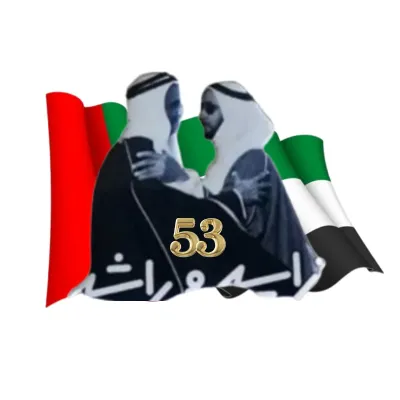The Meaning of Bahrain Flag Colors
What is the meaning of the Colors of Bahrain Flag?

Color holds a profound significance in our lives, often influencing our perceptions, emotions, and cultural expressions. In the tapestry of Bahrain's rich cultural heritage, colors play a pivotal role, weaving stories of tradition, symbolism, and identity. From the azure hues of its coastline to the golden sands of its deserts, Bahrain's vibrant palette reflects the essence of its people, history, and landscapes. In this exploration, we delve into the meanings behind the colors that adorn Bahrain, unraveling the threads of its cultural fabric.
Design
Background
The flag consists of a red stripe on the top and a white stripe on the bottom, with a serrated line dividing them. These colors are deeply rooted in Bahraini history and culture, each carrying significant symbolism.
Red Stripe
The upper red stripe represents the Kharijite Islamic sect, which has historical significance in Bahrain. Red is a color associated with courage, sacrifice, and the struggle for independence.
White Stripe
The lower white stripe symbolizes the ruling Al Khalifa family and signifies peace, unity, and harmony. White is often associated with purity, spirituality, and the nation's commitment to peace and stability.
Serrated Line
The serrated line dividing the two stripes represents the Bahrain Fort or Qal'at al-Bahrain, an ancient archaeological site and UNESCO World Heritage Site. This feature serves as a historical reference to Bahrain's rich heritage and its significance as a center of trade and civilization.
Meaning and Symbolism
The design of the Bahraini flag encapsulates the nation's history, culture, and aspirations. The combination of red and white reflects the unity of the Bahraini people and their commitment to freedom, peace, and progress. The inclusion of the serrated line pays homage to Bahrain's ancient past and cultural heritage, serving as a reminder of the nation's resilience and enduring legacy.
Demonstration of colors
Red: Courage and Resilience
The fiery hues of red resonate deeply with Bahrain's history of struggle and resilience. Symbolizing courage, strength, and determination, red embodies the spirit of Bahrain's people in their quest for freedom and justice. From the crimson banners of protest to the scarlet hues of the setting sun, red serves as a poignant reminder of Bahrain's ongoing journey toward democracy and human rights.
White: Purity and Unity
In Bahrain's multicultural society, white emerges as a symbol of purity, peace, and unity. Adorning the traditional attire of both men and women, white signifies the harmonious coexistence of diverse ethnic and religious communities. Moreover, white embodies the pristine beauty of Bahrain's architecture, from the gleaming domes of mosques to the whitewashed facades of historic buildings, reflecting the nation's timeless elegance and cultural heritage.
Gold: Prosperity and Royalty
The radiant glow of gold embodies Bahrain's legacy of wealth, prosperity, and royal heritage. From the shimmering sands of its deserts to the opulent treasures of its souks, gold symbolizes abundance, luxury, and prestige. Moreover, gold holds spiritual significance in Bahrain's rich history, adorning the intricate designs of its mosques, temples, and palaces, reflecting the nation's enduring legacy of craftsmanship and artistic excellence.
History of Bahrain Flag
Pre-Independence
Before Bahrain's independence, the region was under British influence. The flag used during this period featured the British Union Jack in the canton (upper left corner) with a white field. This flag symbolized Bahrain's status as a British protectorate.
First Bahraini Flag
In 1932, Bahrain adopted its first national flag, known as the "Persian Gulf Flag." It featured a red field with a white serrated stripe running diagonally from the upper hoist side to the lower fly side. The design was inspired by the traditional sail of a dhow, a type of sailing vessel commonly used in the region for trade and fishing.
Union with Qatar
Between 1958 and 1971, Bahrain and Qatar formed a union known as the State of Bahrain and Qatar. During this period, the flag of the union was used, featuring a combination of Bahraini and Qatari elements.
Post-Independence
Bahrain gained independence from Britain on August 15, 1971, and adopted a new national flag to reflect its sovereignty. The current flag of Bahrain was officially hoisted for the first time on September 3, 1971, replacing the previous flag used during the union with Qatar.
Evolution and Symbolism
The design of the current flag reflects Bahrain's rich history, culture, and aspirations. The colors and symbols used in the flag embody the unity, resilience, and cultural heritage of the Bahraini people. Over the years, the flag has become a powerful symbol of national pride and identity, representing Bahrain's commitment to independence, peace, and progress.
Conclusion
In the kaleidoscope of Bahrain's cultural tapestry, colors serve as a vibrant expression of its identity, heritage, and aspirations. From the tranquil blues of its coastline to the fiery reds of its struggle for democracy, each hue weaves a story of resilience, unity, and hope. As Bahrain continues to evolve and embrace its future, its colors will remain a timeless symbol of its enduring spirit and cultural richness, inspiring generations to come.
Spotlight on Trending Promo Gear
Browse the most popular and trending Corporate Gifts




















